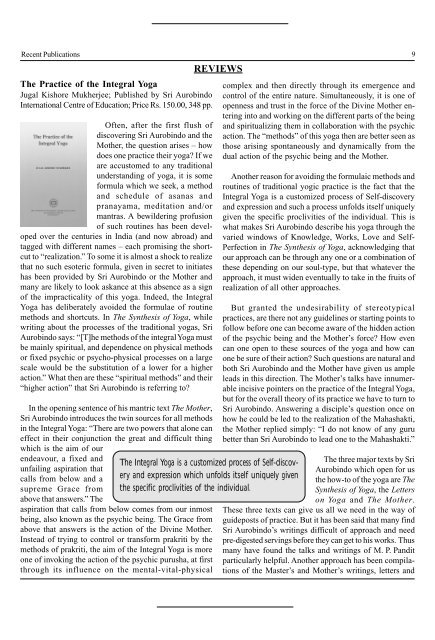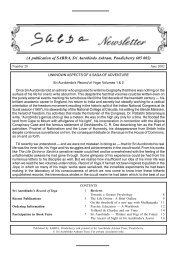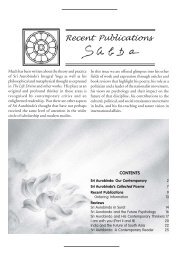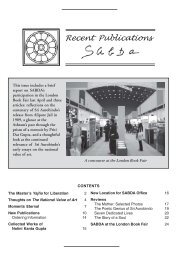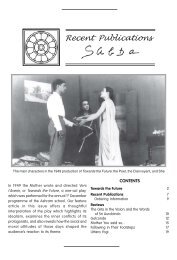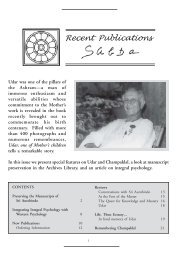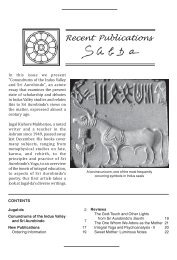Recent Publications - Sabda - Sri Aurobindo Ashram
Recent Publications - Sabda - Sri Aurobindo Ashram
Recent Publications - Sabda - Sri Aurobindo Ashram
Create successful ePaper yourself
Turn your PDF publications into a flip-book with our unique Google optimized e-Paper software.
<strong>Recent</strong> <strong>Publications</strong> 9The Practice of the Integral YogaJugal Kishore Mukherjee; Published by <strong>Sri</strong> <strong>Aurobindo</strong>International Centre of Education; Price Rs. 150.00, 348 pp.Often, after the first flush ofdiscovering <strong>Sri</strong> <strong>Aurobindo</strong> and theMother, the question arises – howdoes one practice their yoga? If weare accustomed to any traditionalunderstanding of yoga, it is someformula which we seek, a methodand schedule of asanas andpranayama, meditation and/ormantras. A bewildering profusionof such routines has been developedover the centuries in India (and now abroad) andtagged with different names – each promising the shortcutto “realization.” To some it is almost a shock to realizethat no such esoteric formula, given in secret to initiateshas been provided by <strong>Sri</strong> <strong>Aurobindo</strong> or the Mother andmany are likely to look askance at this absence as a signof the impracticality of this yoga. Indeed, the IntegralYoga has deliberately avoided the formulae of routinemethods and shortcuts. In The Synthesis of Yoga, whilewriting about the processes of the traditional yogas, <strong>Sri</strong><strong>Aurobindo</strong> says: “[T]he methods of the integral Yoga mustbe mainly spiritual, and dependence on physical methodsor fixed psychic or psycho-physical processes on a largescale would be the substitution of a lower for a higheraction.” What then are these “spiritual methods” and their“higher action” that <strong>Sri</strong> <strong>Aurobindo</strong> is referring to?In the opening sentence of his mantric text The Mother,<strong>Sri</strong> <strong>Aurobindo</strong> introduces the twin sources for all methodsin the Integral Yoga: “There are two powers that alone caneffect in their conjunction the great and difficult thingwhich is the aim of ourendeavour, a fixed andunfailing aspiration thatcalls from below and asupreme Grace fromabove that answers.” Theaspiration that calls from below comes from our inmostbeing, also known as the psychic being. The Grace fromabove that answers is the action of the Divine Mother.Instead of trying to control or transform prakriti by themethods of prakriti, the aim of the Integral Yoga is moreone of invoking the action of the psychic purusha, at firstthrough its influence on the mental-vital-physicalREVIEWSThe Integral Yoga is a customized process of Self-discoveryand expression which unfolds itself uniquely giventhe specific proclivities of the individual.complex and then directly through its emergence andcontrol of the entire nature. Simultaneously, it is one ofopenness and trust in the force of the Divine Mother enteringinto and working on the different parts of the beingand spiritualizing them in collaboration with the psychicaction. The “methods” of this yoga then are better seen asthose arising spontaneously and dynamically from thedual action of the psychic being and the Mother.Another reason for avoiding the formulaic methods androutines of traditional yogic practice is the fact that theIntegral Yoga is a customized process of Self-discoveryand expression and such a process unfolds itself uniquelygiven the specific proclivities of the individual. This iswhat makes <strong>Sri</strong> <strong>Aurobindo</strong> describe his yoga through thevaried windows of Knowledge, Works, Love and Self-Perfection in The Synthesis of Yoga, acknowledging thatour approach can be through any one or a combination ofthese depending on our soul-type, but that whatever theapproach, it must widen eventually to take in the fruits ofrealization of all other approaches.But granted the undesirability of stereotypicalpractices, are there not any guidelines or starting points tofollow before one can become aware of the hidden actionof the psychic being and the Mother’s force? How evencan one open to these sources of the yoga and how canone be sure of their action? Such questions are natural andboth <strong>Sri</strong> <strong>Aurobindo</strong> and the Mother have given us ampleleads in this direction. The Mother’s talks have innumerableincisive pointers on the practice of the Integral Yoga,but for the overall theory of its practice we have to turn to<strong>Sri</strong> <strong>Aurobindo</strong>. Answering a disciple’s question once onhow he could be led to the realization of the Mahashakti,the Mother replied simply: “I do not know of any gurubetter than <strong>Sri</strong> <strong>Aurobindo</strong> to lead one to the Mahashakti.”The three major texts by <strong>Sri</strong><strong>Aurobindo</strong> which open for usthe how-to of the yoga are TheSynthesis of Yoga, the Letterson Yoga and The Mother.These three texts can give us all we need in the way ofguideposts of practice. But it has been said that many find<strong>Sri</strong> <strong>Aurobindo</strong>’s writings difficult of approach and needpre-digested servings before they can get to his works. Thusmany have found the talks and writings of M. P. Panditparticularly helpful. Another approach has been compilationsof the Master’s and Mother’s writings, letters and


